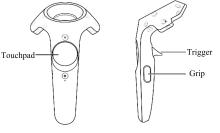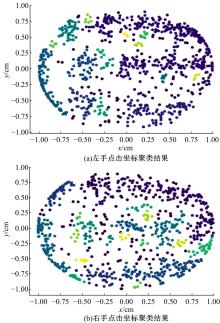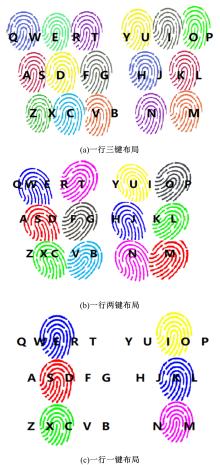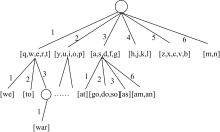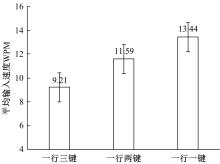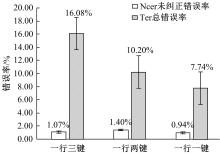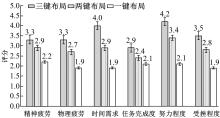Journal of Jilin University(Engineering and Technology Edition) ›› 2022, Vol. 52 ›› Issue (8): 1881-1888.doi: 10.13229/j.cnki.jdxbgxb20210159
Text input based on two⁃handed keyboard in virtual environment
Gui-he QIN( ),Jun-feng HUANG,Ming-hui SUN(
),Jun-feng HUANG,Ming-hui SUN( )
)
- College of Computer Science and Technology,JiLin University,Changchun 130012,China
CLC Number:
- TP391.9
| 1 | 赵剑, 王柳, 史丽娟, 等. 面向言语康复的多模态人机交互系统[J]. 吉林大学学报: 工学版, 2020, 50(4): 1478-1486. |
| Zhao Jian, Wang Liu, Shi Li-juan, et al. Multimodal human-computer interaction system for speech rehabilitation[J]. Journal of Jilin University(Engineering and Technology Edition), 2020, 50(4): 1478-1486. | |
| 2 | Bowman D A, Wingrave C A, Campbell J M, et al. Using pinch gloves(TM) for both natural and abstract interaction techniques in virtual environments[J/OL]. [2021-03-01]. |
| 3 | Yu D, Fan K, Zhang H, et al. Pizzatext: text entry for virtual reality systems using dual thumbsticks[J]. IEEE Transactions on Visualization and Computer Graphics, 2018, 24(11): 2927-2935. |
| 4 | Kim Y R, Kim G J. Hovr-type: smartphone as a typing interface in vr using hovering[C]∥IEEE International Conference on Consumer Electronics(ICCE), Seoul, Republic of Korea, 2017: 200-203. |
| 5 | Lee Y, Kim G J. Vitty: virtual touch typing interface with added finger buttons[C]∥International Conference on Virtual, Augmented and Mixed Reality, Seoul, Republic of Korea, 2017: 111-119. |
| 6 | Cui W, Zheng J, Lewis B, et al. Hotstrokes: word-gesture shortcuts on a trackpad[C]∥Proceedings of the 2019 CHI Conference on Human Factors in Computing Systems, Glasgow, Scotland UK,2019: 1-13. |
| 7 | Bowman D A, Rhoton C J, Pinho M S. Text input techniques for immersive virtual environments: an empirical comparison[C]∥Proceedings of the Human Factors and Ergonomics Society Annual Meeting, Baltimore, USA, 2002: 2154-2158. |
| 8 | Pick S, Puika A S, Kuhlen T W. Swifter: design and evaluation of a speech-based text input metaphor for immersive virtual environments[C]∥IEEE Symposium on 3D User Interfaces(3DUI), Greenville, USA, 2016: 109-112. |
| 9 | 梁士利, 魏莹, 潘迪, 等. 基于语谱图行投影的特定人二字汉语词汇识别[J]. 吉林大学学报: 工学版, 2017, 47(1): 294-300. |
| Liang Shi-li, Wei Ying, Pan Di, et al. Recognition to specific two words Chinese vocabulary based on projection matrix of spectrogram[J]. Journal of Jilin University(Engineering and Technology Edition), 2017, 47(1): 294-300. | |
| 10 | Wobbrock J O, Myers B A, Aung H H. Writing with a joystick: a comparison of date stamp, selection keyboard, and edgewrite[C]∥Proceedings of Graphics Interface, London, Canada, 2004: 1-8. |
| 11 | MacKenzie I S. KSPC (keystrokes per character) as a characteristic of text entry techniques[C]∥International Conference on Mobile Human-Computer Interaction, Berlin, Heidelberg, 2002: 195-210. |
| 12 | Venolia D, Neiberg F. T-Cube: a fast, self-disclosing pen-based alphabet[C]∥Proceedings of the SIGCHI Conference on Human Factors in Computing Systems, Pisa, Italy, 1994: 265-270. |
| 13 | Zhao S, Dragicevic P, Chignell M, et al. EarPod: eyes-free menu selection using touch input and reactive audio feedback[C]∥Proceedings of the SIGCHI Conference on Human Factors in Computing Systems, California, USA, 2007: 1395-1404. |
| 14 | Benligiray B, Topal C, Akinlar C. SliceType: fast gaze typing with a merging keyboard[J]. Journal on Multimodal User Interfaces, 2019, 13(4): 321-334. |
| 15 | Mottelson A, Larsen C, Lyderik M, et al. Invisiboard: maximizing display and input space with a full screen text entry method for smartwatches[C]∥Proceedings of the 18th International Conference on Human-Computer Interaction with Mobile Devices and Services, Florence, Italy, 2016: 53-59. |
| 16 | Poirier F, Belatar M. Uniwatch: a soft keyboard for text entry on smartwatches using 3 keys watch user-interface and user evaluation[C]∥International Conference on Human-Computer Interaction, Toronto, Canada, 2016: 341-349. |
| 17 | Jiang H, Weng D. HiPad: text entry for head-mounted displays using circular touchpad[C]∥IEEE Conference on Virtual Reality and 3D User Interfaces(VR), Atlanta, United States, 2020: 692-703. |
| 18 | MacKenzie I S. Fitts' law as a research and design tool in human-computer interaction[J]. Human-computer Interaction, 1992, 7(1): 91-139. |
| 19 | Vertanen K, Kristensson P O. Complementing text entry evaluations with a composition task[J]. ACM Transactions on Computer-Human Interaction, 2014, 21(2): 2555691. |
| 20 | Levenshtein V I. Binary codes capable of correcting deletions, insertions, and reversals[J]. Soviet Physics Doklady, 1966, 10(8): 707-710. |
| [1] | Tian BAI,Ming-wei XU,Si-ming LIU,Ji-an ZHANG,Zhe WANG. Dispute focus identification of pleading text based on deep neural network [J]. Journal of Jilin University(Engineering and Technology Edition), 2022, 52(8): 1872-1880. |
| [2] | Fu-heng QU,Tian-yu DING,Yang LU,Yong YANG,Ya-ting HU. Fast image codeword search algorithm based on neighborhood similarity [J]. Journal of Jilin University(Engineering and Technology Edition), 2022, 52(8): 1865-1871. |
| [3] | Zhen WANG,Meng GAI,Heng-shuo XU. Surface reconstruction algorithm of 3D scene image based on virtual reality technology [J]. Journal of Jilin University(Engineering and Technology Edition), 2022, 52(7): 1620-1625. |
| [4] | Ming LIU,Yu-hang YANG,Song-lin ZOU,Zhi-cheng XIAO,Yong-gang ZHANG. Application of enhanced edge detection image algorithm in multi-book recognition [J]. Journal of Jilin University(Engineering and Technology Edition), 2022, 52(4): 891-896. |
| [5] | Shi-min FANG. Multiple source data selective integration algorithm based on frequent pattern tree [J]. Journal of Jilin University(Engineering and Technology Edition), 2022, 52(4): 885-890. |
| [6] | Sheng-sheng WANG,Jing-yu CHEN,Yi-nan LU. COVID⁃19 chest CT image segmentation based on federated learning and blockchain [J]. Journal of Jilin University(Engineering and Technology Edition), 2021, 51(6): 2164-2173. |
| [7] | Hong-wei ZHAO,Zi-jian ZHANG,Jiao LI,Yuan ZHANG,Huang-shui HU,Xue-bai ZANG. Bi⁃direction segmented anti⁃collision algorithm based on query tree [J]. Journal of Jilin University(Engineering and Technology Edition), 2021, 51(5): 1830-1837. |
| [8] | Jie CAO,Xue QU,Xiao-xu LI. Few⁃shot image classification method based on sliding feature vectors [J]. Journal of Jilin University(Engineering and Technology Edition), 2021, 51(5): 1785-1791. |
| [9] | Chun-bo WANG,Xiao-qiang DI. Cloud storage integrity verification audit scheme based on label classification [J]. Journal of Jilin University(Engineering and Technology Edition), 2021, 51(4): 1364-1369. |
| [10] | Rong QIAN,Ru ZHANG,Ke-jun ZHANG,Xin JIN,Shi-liang GE,Sheng JIANG. Capsule graph neural network based on global and local features fusion [J]. Journal of Jilin University(Engineering and Technology Edition), 2021, 51(3): 1048-1054. |
| [11] | Qian-yi XU,Gui-he QIN,Ming-hui SUN,Cheng-xun MENG. Classification of drivers' head status based on improved ResNeSt [J]. Journal of Jilin University(Engineering and Technology Edition), 2021, 51(2): 704-711. |
| [12] | Yuan SONG,Dan-yuan ZHOU,Wen-chang SHI. Method to enhance security function of OpenStack Swift cloud storage system [J]. Journal of Jilin University(Engineering and Technology Edition), 2021, 51(1): 314-322. |
| [13] | Xiang-jiu CHE,You-zheng DONG. Improved image recognition algorithm based on multi⁃scale information fusion [J]. Journal of Jilin University(Engineering and Technology Edition), 2020, 50(5): 1747-1754. |
| [14] | HU Guan-yu, QIAO Pei-li. High dimensional differential evolutionary algorithm based on cloud population for network security prediction [J]. 吉林大学学报(工学版), 2016, 46(2): 568-577. |
| [15] | ZHAO Wei, QU Hui-yan. Fast collision detection algorithm based on Cloud Map-Reduce model [J]. 吉林大学学报(工学版), 2016, 46(2): 578-584. |
|
||
